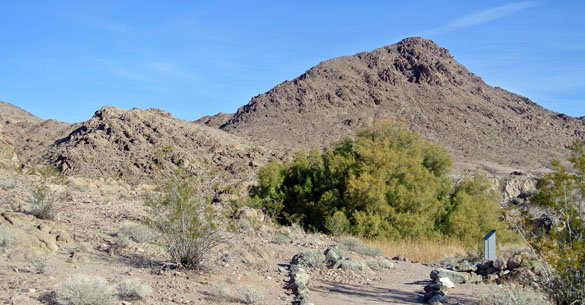 ZZYZX, CALIFORNIA–This was our last full day of geological adventures in the Mojave Desert for 2013. The weather was even warmer than yesterday, with the temperature in Baker at 4:00 p.m. a delightful 94°F. We began in the usual way from our temporary home at the Desert Studies Center, heading north of Baker again to Shoshone and the Tecopa area. Our first stop was at Salt Creek Spring in the Salt Spring Hills, one of the rare riparian environments in this part of the desert. This place is also notable as the first place gold was found in southern California. This discovery in 1849 began the boom in mining throughout the Mojave Desert.
ZZYZX, CALIFORNIA–This was our last full day of geological adventures in the Mojave Desert for 2013. The weather was even warmer than yesterday, with the temperature in Baker at 4:00 p.m. a delightful 94°F. We began in the usual way from our temporary home at the Desert Studies Center, heading north of Baker again to Shoshone and the Tecopa area. Our first stop was at Salt Creek Spring in the Salt Spring Hills, one of the rare riparian environments in this part of the desert. This place is also notable as the first place gold was found in southern California. This discovery in 1849 began the boom in mining throughout the Mojave Desert.
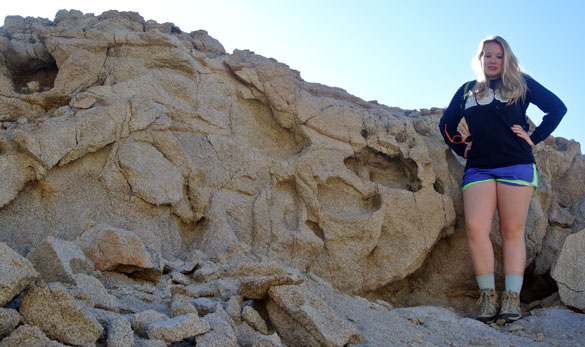 One of the interesting geological features we noted was the occurrence of the familiar tafoni, but this time in a deeply eroded outcrop of quartz monzonite (shown above with Melissa Torma). Our companion Yoav Avni believes this may represent a Pleistocene pluvial phase of erosion that has been exhumed in the modern landscape. Tafoni features in granite would seem to require more water than is present today in this system, thus placing these features during a wet interval makes sense.
One of the interesting geological features we noted was the occurrence of the familiar tafoni, but this time in a deeply eroded outcrop of quartz monzonite (shown above with Melissa Torma). Our companion Yoav Avni believes this may represent a Pleistocene pluvial phase of erosion that has been exhumed in the modern landscape. Tafoni features in granite would seem to require more water than is present today in this system, thus placing these features during a wet interval makes sense.
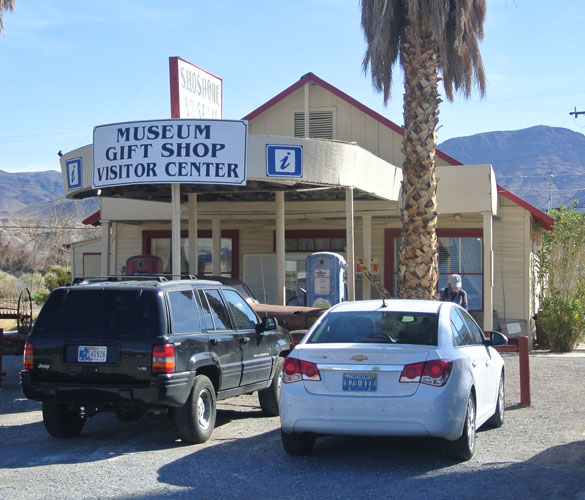 We next returned to the little settlement of Shoshone, this time visiting the town museum (above). It is well worth touring for its local artifacts, some wildlife displays, and the bones and teeth of the Shoshone Mammoth found in the Tecopa lake sediments.
We next returned to the little settlement of Shoshone, this time visiting the town museum (above). It is well worth touring for its local artifacts, some wildlife displays, and the bones and teeth of the Shoshone Mammoth found in the Tecopa lake sediments.
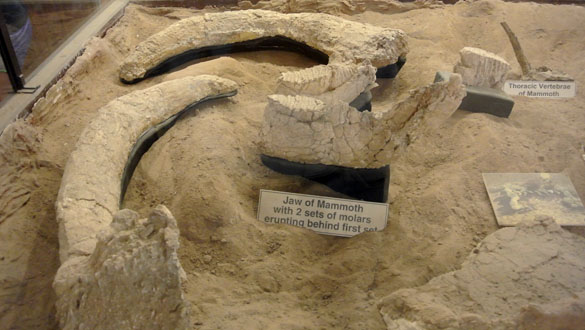 The mammoth (Archidiskodon tamenensis on the sign) has been very well preserved by the lake clays and silts, especially the diagnostic teeth and jaws. It is an impressive find and an important addition to our knowledge of the ancient Lake Tecopa ecosystem.
The mammoth (Archidiskodon tamenensis on the sign) has been very well preserved by the lake clays and silts, especially the diagnostic teeth and jaws. It is an impressive find and an important addition to our knowledge of the ancient Lake Tecopa ecosystem.
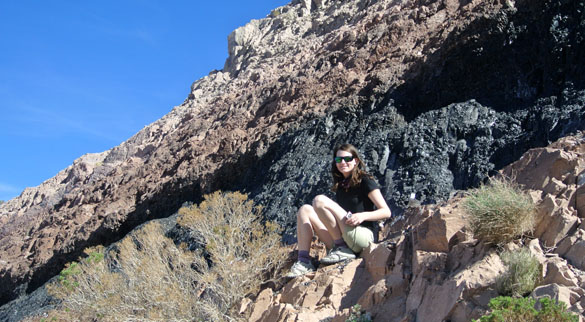 The Resting Springs Welded Tuff exposed east of Shoshone is one of the most famous roadcuts in the Mojave Desert. Above we see Olivia Brown exploring the glassy black middle of the unit. The colors and hardnesses of the rocks here show degrees of welding from the intense heat developed in this pyroclastic flow. It is technically a devitrified pumice tuff, welded tuff, and vesicular vitrophyre dated by K-Ar methods as 9.5 million years old. The fiamme are fantastic.
The Resting Springs Welded Tuff exposed east of Shoshone is one of the most famous roadcuts in the Mojave Desert. Above we see Olivia Brown exploring the glassy black middle of the unit. The colors and hardnesses of the rocks here show degrees of welding from the intense heat developed in this pyroclastic flow. It is technically a devitrified pumice tuff, welded tuff, and vesicular vitrophyre dated by K-Ar methods as 9.5 million years old. The fiamme are fantastic.
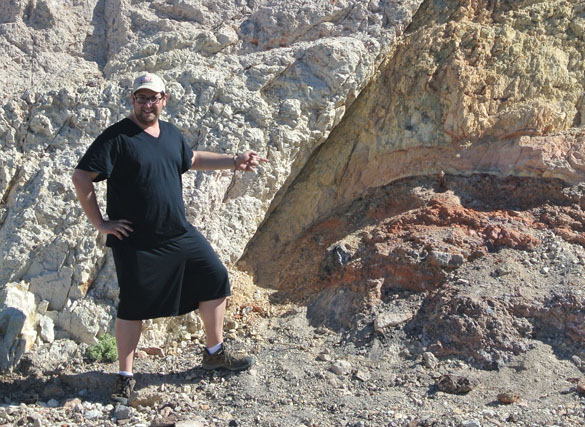 In the same outcrop of the Resting Springs Tuff are some impressive faults. Jonah Novek is showing above how he knows this is a normal fault because the drag fold shows downward movement of the hanging wall (the side he is standing on).
In the same outcrop of the Resting Springs Tuff are some impressive faults. Jonah Novek is showing above how he knows this is a normal fault because the drag fold shows downward movement of the hanging wall (the side he is standing on).
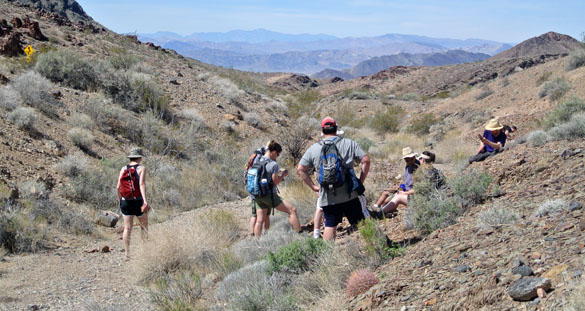 At lunchtime we arrived at Emigrant Pass east of Tecopa to collect trilobites from the Cambrian Carrara Formation exposed on the north side of the highway (which happened to be the Old Spanish Trail). After a bit of exploring, our ace field geologist Shelley Judge found the most fossiliferous outcrops. We found hundreds of the fascinating critters, leaving most for future field trips. I like the view above, by the way, because it shows Telescope Peak on the far distant skyline.
At lunchtime we arrived at Emigrant Pass east of Tecopa to collect trilobites from the Cambrian Carrara Formation exposed on the north side of the highway (which happened to be the Old Spanish Trail). After a bit of exploring, our ace field geologist Shelley Judge found the most fossiliferous outcrops. We found hundreds of the fascinating critters, leaving most for future field trips. I like the view above, by the way, because it shows Telescope Peak on the far distant skyline.
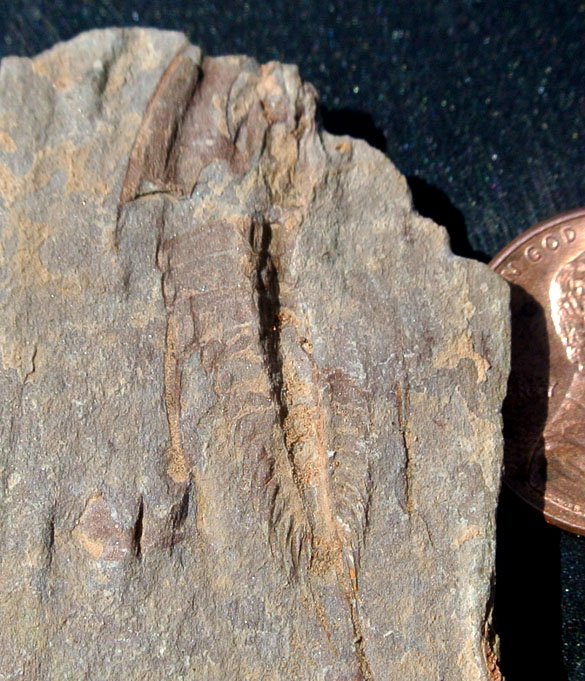 The best trilobite of the day (and there were many good specimens) was collected by Olivia Brown. It is a rare whole specimen, apparently of the genus Olenellus. You can see all the thoracic segments and spines, as well as the pygidium. The way the cephalon is separated from the thorax may indicate that it is a preserved exuvium (molt). Very nice.
The best trilobite of the day (and there were many good specimens) was collected by Olivia Brown. It is a rare whole specimen, apparently of the genus Olenellus. You can see all the thoracic segments and spines, as well as the pygidium. The way the cephalon is separated from the thorax may indicate that it is a preserved exuvium (molt). Very nice.
 Following a geological tradition transferred from Sonoma State University geologists to us via my friend Matthew James, we visited China Ranch south of Tecopa and had date milkshakes. Delicious and refreshingly cool on what turned out to be a very hot day. We also had a good geology lesson with the fanglomerates and ancient lakebeds exposed around the date groves.
Following a geological tradition transferred from Sonoma State University geologists to us via my friend Matthew James, we visited China Ranch south of Tecopa and had date milkshakes. Delicious and refreshingly cool on what turned out to be a very hot day. We also had a good geology lesson with the fanglomerates and ancient lakebeds exposed around the date groves.
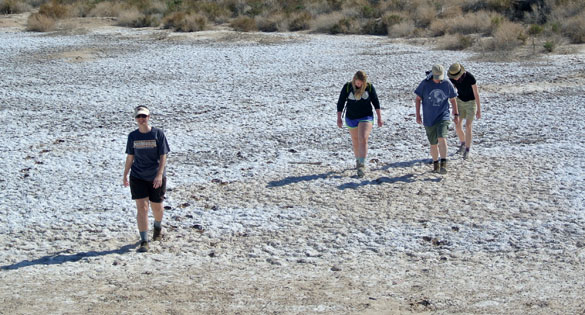 While driving out of Tecopa, we stopped to walk out onto the Lake Tecopa playa, which was covered by a thin crust of salts. From the left are Meagen Pollock, Melissa Torma, Shelley Judge and Olivia Brown. We observed the modern playa sediments juxtaposed with the ancient lake strata exposed as low mounds.
While driving out of Tecopa, we stopped to walk out onto the Lake Tecopa playa, which was covered by a thin crust of salts. From the left are Meagen Pollock, Melissa Torma, Shelley Judge and Olivia Brown. We observed the modern playa sediments juxtaposed with the ancient lake strata exposed as low mounds.
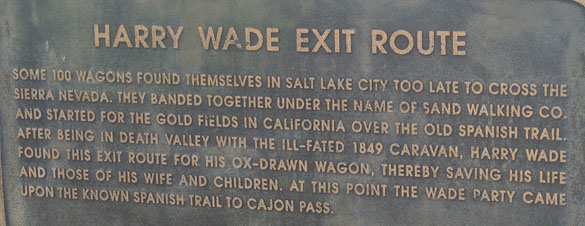 Last of all was a stop to briefly recognize the Harry Wade exit route out of Death Valley at an historical marker on the highway back to Baker. We came full circle at this point, since we started with Death Valley and now ended looking back into that source of such hardship in 1849.
Last of all was a stop to briefly recognize the Harry Wade exit route out of Death Valley at an historical marker on the highway back to Baker. We came full circle at this point, since we started with Death Valley and now ended looking back into that source of such hardship in 1849.
Our final scientific event of the day was an excellent tour of the night sky by the Laboratory Technician of the Vassar College Environmental Sciences and Geography Department, Rick Jones. The sky is very dark and inviting in this lonely part of the desert.


